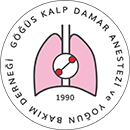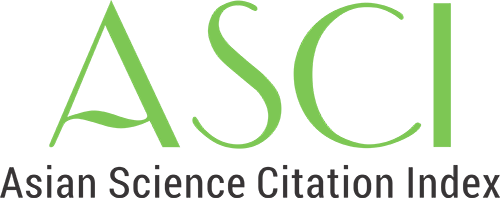

Volume: 26 Issue: 3 - 2020
| 1. | Cover Page I (680 accesses) |
| 2. | Editorial Consultants Page II (577 accesses) |
| 3. | Contents Pages III - IV (580 accesses) |
| 4. | Publication Policies and Writing Guide Pages V - X (674 accesses) |
| RESEARCH ARTICLE | |
| 5. | Neuroprotective Effects of Levosimendan on the NB2a Mouse Neuroblastoma Cell Culture Tülün Öztürk, Kamil Vural, Işıl Aydemi&775;r, Mehmet İbrahim Tuğlu doi: 10.5222/GKDAD.2020.07078 Pages 115 - 122 (1006 accesses) INTRODUCTION: Levosimendan (LVS) inhibits phosphodiestherase III and opens the ATP-sensitive K+ channels (KATP). It is cardioprotective due to its anti-oxidant, anti-inflammatuary, inotropic and vasodilatatory effects. The use of LVS is prefered in patients who have decreased ejection fraction during cardiac surgery. Therefore it has been reported that LVS protects neurons indirectly. Hovewer, its direct effects on neurons have not been known yet. We examined direct neuroprotective effects of LVS using neuroblastoma cell line of mouse origin (NB2a) in culture where drug interaction with cells occurs. METHODS: To this end, the neuroprotective effects of LVS (0,1, 0,3, 1, 3, 10, 30 and 100 μM) have been tested for its direct toxic effects by TUNEL method for apoptosis and by MTT for cell viability. We also examined moderate and chronic toxic effect of LSV by measure neurite outgrowth. RESULTS: LVS didnt effect the cellular proliferation negatively. The number of apoptotic cells didnt differ from the number of control cells (p>0.05). Additionally, any moderate neurotoxic effects were not seen in all concentrations of NST which did not inhibit neurite outgrowth. Moreover, LVS at 1 μM concentration significantly increased the lengh of neurite showing clearly its neuroprotective and functional effects. DISCUSSION AND CONCLUSION: These direct neuroprotective effects of LVS in culture might be important for clinical use. LVS can be used securely in patients that have a risk for a brain injury due to the nature of disease, trauma or the procedure itself. |
| 6. | Comparison of Intubated Versus Non-Intubated Techniques in Video-Assisted Thoracoscopic Sympathectomy Ufuk Turan, Serkan Şenkal doi: 10.5222/GKDAD.2020.68736 Pages 123 - 132 (936 accesses) INTRODUCTION: The use of Non-Intubated Video Assisted Thoracoscopic Surgery (NIVATS) technique is gradually increasing as an alternative method to classical intubation in minor Video Assisted Thoracoscopic Surgeries (VATS) such as sympathectomy, pleural biopsy, lung parenchymal biopsy, pleurodesis and bullectomy. Our aim was to compare a NIVATS technique with the classical intubation method applied in bilateral and uniportal sympathectomies in terms of feasibility and perioperative effects. METHODS: According to the use of Laryngeal Mask Airway (LMA) or Double Lumen Tube (DLT), the patients were evaluated in two groups as Group LMA (n: 20) and Group DLT (n: 20). Demographic data, anesthesia and surgery times, respiratory parameters, surgical feasibility assessment, the postoperative oral intake and mobilization starting times, pain scores, sore throat, nausea-vomiting, air leak, pneumothorax at postoperative follow-ups, and length of hospital stay were compared between groups. RESULTS: Anesthesia induction time was significantly lower in the LMA group (p<0.001). Maximum EtCO2, minimum SpO2, and maximum respiratory rate were significantly higher in the LMA group (p<0.001). Mean FiO2 and mean TV were significantly higher in the DLT group (p<0.05). There was no statistically significant difference between the two groups in terms of surgical feasibility. There was a significant difference between the time of starting oral feeding and mobilizing (p<0.05). There was no statistically significant difference between pain scores, postoperative complications and length of hospital stay. DISCUSSION AND CONCLUSION: Our data suggest that LMA NIVATS technique by preserving spontaneous ventilation and establishing iatrogenic open pneumothorax is a feasible and safe strategy in bilateral and uniportal VATS sympathectomy. |
| 7. | Comparison of Ciaglia and Griggs Percutaneous Dilatation Tracheostomy Methods: Which one is more effective and safe? Şerife Bektaş, Mine Altınkaya Çavuş, İbrahim Mungan, Sema Turan doi: 10.5222/GKDAD.2020.91819 Pages 133 - 138 (867 accesses) INTRODUCTION: To evaluate Griggs (GWDR) and Ciaglia Blue Rhino (CBR) percutaneous dilatation tracheostomy methods with their advantages and disadvantages and to determine their superiority to each other. METHODS: A total of 84 patients who underwent percutaneous dilatation tracheostomy between 2015 and 2016 were included in the study. Bronchoscopy-guided tracheostomy was performed in 42 patients with Ciaglia method and 42 patients with Griggs method. All data of the patients were recorded. RESULTS: The median age of the study population was 65.5 (16-88) years in the CBR group and 66.5 (17-83) years in the GWDR group (p>0.05). The median duration of the procedure was 4 minutes (range, 3.5 to 10 minutes) in the CBR group and 4.5 minutes (range, 3.5 to 11 minutes) in the GBWR group (p>0.05). Minor complications were seen in 20 patients in the CBR group and 26 patients in the GDWR group. Major complications were seen in 13 patients in the CBR group and 10 patients in the GDWR group. The comparison of major and minor complications per se in both groups showed no significant difference. The duration of ICU stays after the procedure was significantly lower in the GDWR group compared to the CBR group (p=0.03). It was observed that obesity increased the risk of complications by 22.89% (95% GA, 5.85-89.55, p=0.01). DISCUSSION AND CONCLUSION: There were no significant differences between GDWR and CBR methods except for small differences. Both methods were found to be effective and safe. |
| 8. | Our Anesthetic Managements in Patients Undergoing Transcatheter Aortic Valve Implantation (TAVI): A Retrospective Study Rukiye Doğan Çakıer, Funda Gümüş Özcan, Serdar Demirgan, Ertuğrul Okuyan, Aysın Selcan doi: 10.5222/GKDAD.2020.93824 Pages 139 - 146 (1198 accesses) INTRODUCTION: Transcatheter Aortic Valve Implantation (TAVI) procedure is a minimally invasive technique that have been applied in aortic stenosis pathologies which carry high-risk for conventional surgery. Although there is no definitive consensus on anesthesic applications, general, local anesthesic and sedation techniques are being used. In this study, we aimed to evaluate our anesthesia methods used in TAVI procedures, and their effects on results. METHODS: The archive records of patients who underwent TAVI procedure due to the severe aortic stenosis between 2013 and 2017 were analyzed. Anesthesic approaches, features of the procedure, and patient outcomes were evaluated. RESULTS: Of the 100 (50 women/50 men) patients who underwent TAVI, 15 had general anesthesia (GA) (15%), and 49 had local anesthesia with sedation (LS) (49%), and 36 had local anesthesia with monitorized anesthesia care (LM) (36%). In the LM group, the anesthesia and procedure times were significantly shorter compared to the GA and LS groups (p<0.05). Vasoactive agenst, and fluid infusions were used more frequently and intensive care (ICU) stay were prolonged in the GA (p<0.05). While the 30-day mortality was 14% in all groups, the mortality rate in the GA was significantly higher than the LS and LM (p=0.007). DISCUSSION AND CONCLUSION: With an increase in technological advances and experience, the need GA for TAVI has decreased and the anesthesia technique has shifted sharply to applications of LS and LM with the advantages they provided. However, regardless of the anesthesia technique, all patients should be followed up closely in the intraoperative period for good patient outcomes. |
| 9. | Lower Respiratory Tract and Urinary System Colonization in Patients with Cardiovascular Surgery Nurşen Tanrıkulu, Ali Haspolat, Ali Şefik Köprülü, Ergun Demirsoy doi: 10.5222/GKDAD.2020.90277 Pages 147 - 156 (949 accesses) INTRODUCTION: Prevention of postoperative infections in cardiovascular surgery is possible with the treatment of preoperative infections. However, there is no routine clinical protocols agreed on patients without clinical complaints with normal laboratory findings but culture positive cultures and lower respiratory or urinary tract colonizations In our study we examined the clinical implication of asymptomatic patients with normal laboratory findings and colonization in their preoperative tracheal/urine cultures. Hence we aimed to identify major risk groups and share possible clinical results. METHODS: Tracheal / urine cultures were obtained preoperatively from the CVS patients who had normal examination and laboratory findings between January 2016 - and June 2019 in our hospital. The patients were retrospectively divided into two groups as those having non reproductive (GI) and reproductive (G-II) cultures, and were compared in terms of demographic data, risk factors, cross-clamping/bypass times, intensive care/hospital stay, blood product consumption, major complications, systemic infection and mortality. RESULTS: Bacterial growth was found in 90 of 307 (61.1 %) patients with normal findings. Most frequently in trachea, Pseudomonas spp., and in urine E.coli were grown. Colonization was found significantly higher in female gender. There was no difference between the groups in terms of DM, HT, creatinine,albumin, EF and PAP values while there was significant difference between smokers and COPD patients. Also, it was found that G-II patients had longer ICU/hospital stay, more frequently required blood products and developed a higher rate of postoperative infection. There was no statistical difference between groups in terms of mortality. DISCUSSION AND CONCLUSION: We believe that smoking and COPD are serious risk factors in CVS operations,and tracheal/ urine culture samples taken during preoperative period may be the guiding reference to high risk cardiovascular patients such as smokers and COPD who may suffer from postoperative infection. |
| 10. | Organ Dysfunction and Mortality Relationship in Patients with Extracorporeal Membrane Oxygenation After Pediatric Cardiac Surgery Nihal Sirakaya Erese, Nurgul Yurtseven, Emine Hekim Yılmaz, Okan Yurdakök, Suna Yaka doi: 10.5222/GKDAD.2020.84756 Pages 157 - 164 (903 accesses) INTRODUCTION: The application of mechanical support devices such as extracorporeal membrane oxygenation(ECMO) has increased with the increase of complex cardiac surgery operations in congenital heart diseases. Despite significant advances in ECMO techniques and methods, the prognosis is still poor. The aim of this study is to show the relationship between organ dysfunction and mortality in patients with veno-arterial (VA)ECMO after pediatric cardiac surgery. METHODS: 63 patients in the pediatric cardiac ICU who had VA-ECMO, were followed up to 48 hours in our clinic, were retrospectively included in the study and two groups were formed. In Group1: Patients with mortality in 30 days(n: 47), Group 2: Living patients (n: 16). Along with the demographic data of the patients, ECMO placement time, creatinine, BUN(blood urea nitrogen), ALT(alanine aminotransferase), AST(aspartate aminotransferase), bilirubin, albumin and platelet levels were recorded. RESULTS: While 36 patients(57.1%) left ECMO in our study group, 16 of these patients (16/63,25.4%) were discharged. A total of 47 patients (47/63, 74.6%) died. Although the number of patients who underwent univentricular repair (26/47,55.31%) in Group 1 was 5(31.25%) higher than Group2, this difference was not significant(p> 0.05). Postoperative ECMO was placed in 27 patients(57.44%) in Group1 and 4 patients(31.25%) in Group2, and this difference was statistically significant (p <0.02). While creatinine, BUN, ALT, AST were higher in Group1 patients who had higher mortality, albumin and platelet values were lower than Group 2(p <0.05). DISCUSSION AND CONCLUSION: Especially when ECMO was placed postoperatively, these patients mortality was high and organ dysfunction parameters were found to be effective in showing mortality. |
| 11. | Impact of High Body Mass Index on Morbidity and Mortality ın Cardiac Surgery Cardiac Surgery and Obesity Funda Gümüş Özcan, Serdar Demirgan, Taner Abdullah, Aysın Selcan doi: 10.5222/GKDAD.2020.40316 Pages 165 - 171 (947 accesses) INTRODUCTION: In this study, we evaluated the effects of body mass index on mortality and morbidity after cardiac surgery. METHODS: The record of 813 patients who performed open-heart surgery in our clinic were retrospectively analyzed. 505 patients with complete records were included in the study. Postoperative mortality and morbidity developments were compared in patients with a body mass index of (BMI) ≥30 kg/㎡ and BMI ≤30 kg/㎡ from the records. RESULTS: 389 (%70) of patients were BMI < 30 kg/㎡, non-obese (Group N), 166 of them were BMI ≥30 kg/㎡, obese (Group OB). The mean age of groups (59.2±12.5, 59.6±9.6 years, respectively, p = 0.65) was similar. Female gender, Diabetes Mellitus (DM), hypertension, hyperlipidemia were more common in Group OB (p<0.05). Intraoperative cardiopulmonary bypass (101±43, 98±42 p=0.26) and the duration of aortic cross clamp (64±32.7, 61.6±32.5 p=0.21) were similar. Post-operative complications of pulmonary (%19, %10) and renal (%13, %9) were significantly higher in Group OB (p<0.05), tamponade (%3.1, %0.6) and bleeding revision (%5.7, %1.8) were higher in Group N (p<0.05). Mortality occurred in 27 (5%) patients after surgery. There was no significant difference between mortality rates, ICU and hospital stay (p <0.05). DISCUSSION AND CONCLUSION: High BMI (≥30 kg/㎡) is associated with respiratory system and renal complications after cardiac surgery, and low BMI(< 30 kg/㎡) is associated with morbidities such as tamponade and bleeding revision. |
| LETTER TO THE EDITOR | |
| 12. | Investigation of the effects of melatonin premedication on intraoperative and postoperative hemodynamic parameters, peripheral oxygen saturation, postoperative anxiety and cognitive functions in patients undergoing epidural anesthesia; Letter to edit Melis Tosun, Fevzi Toraman doi: 10.5222/GKDAD.2020.33600 Pages 172 - 175 (733 accesses) Abstract | |
| 13. | Letter To Editor Merve Şeker, Fevzi Toraman doi: 10.5222/GKDAD.2020.81904 Pages 176 - 177 (711 accesses) Abstract | |
| 14. | Letter to the Editor Emir Kılınç, Bülent Güçyetmez, Fevzi Toraman doi: 10.5222/GKDAD.2020.33255 Pages 178 - 182 (824 accesses) Abstract | |
| CASE REPORT | |
| 15. | Two Cases with Persistent Left Superior Vena Cava with Absence of Right Superior Vena Cava Umut Kocabaş doi: 10.5222/GKDAD.2020.60134 Pages 181 - 185 (969 accesses) Persistent left superior vena cava (PLSVC) is the most common congenital venous anomaly of the thorax. PLSVC with absent right superior vena cava (RSVC) which is also termed as isolated PLSVC is a rare entity and estimated to be present 0.09-0.13% of patients. PLSVC with absent RSVC is usually asymptomatic but its presence can lead to serious complications. In this report, we describe two cases of PLSVC with absent RSVC and its clinical implications. |
| 16. | Our anesthesia management in patient with combined coronary and carotis surgery Dilek Çetinkaya, İlker Uğurlu doi: 10.5222/GKDAD.2020.45822 Pages 186 - 188 (802 accesses) operations. Coexistence of carotid stenosis further disrupts perfusion. In this case presentation, we aimed to present our anesthetic management during combined CAB and right carotid endarterectomy (CEA) surgery in a patient with a completely occluded right carotid artery and a 50-70% stenosis in the left carotid artery. |

















